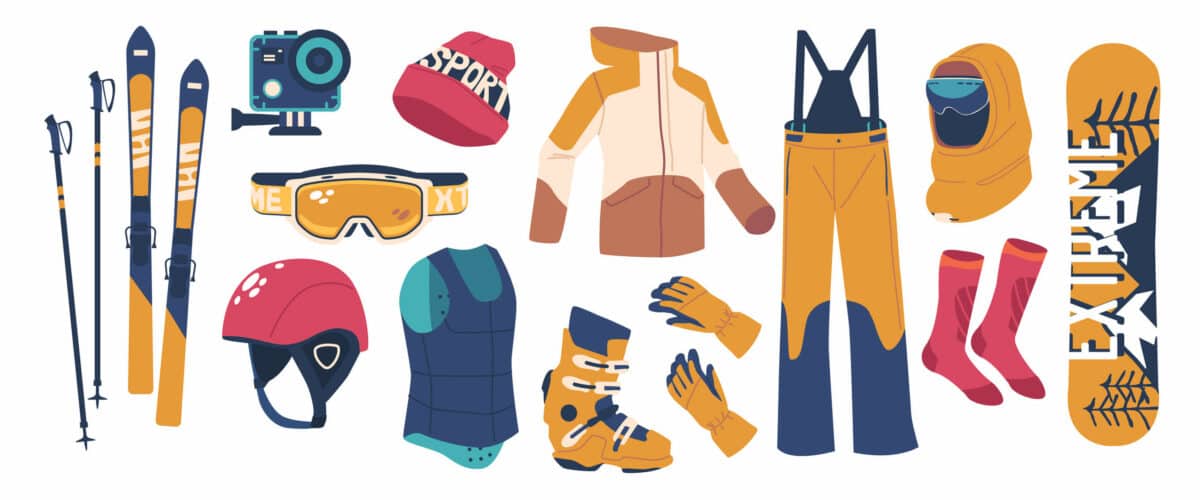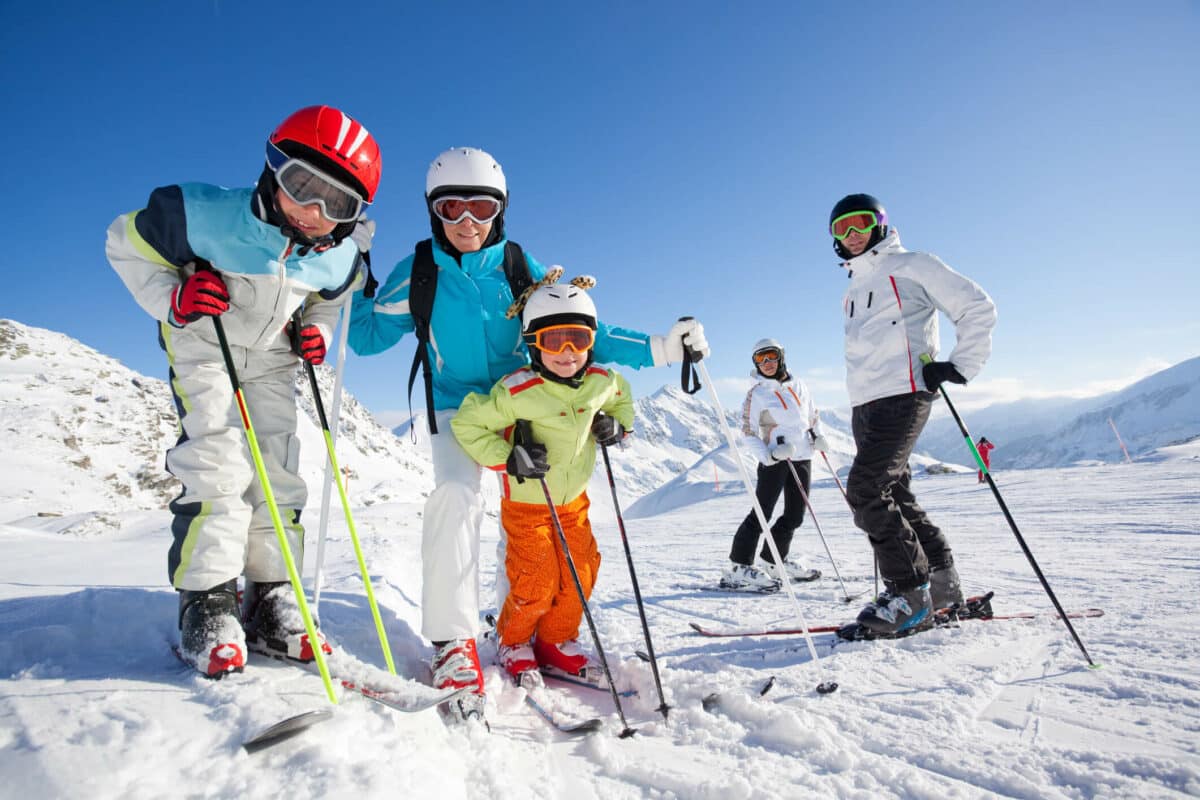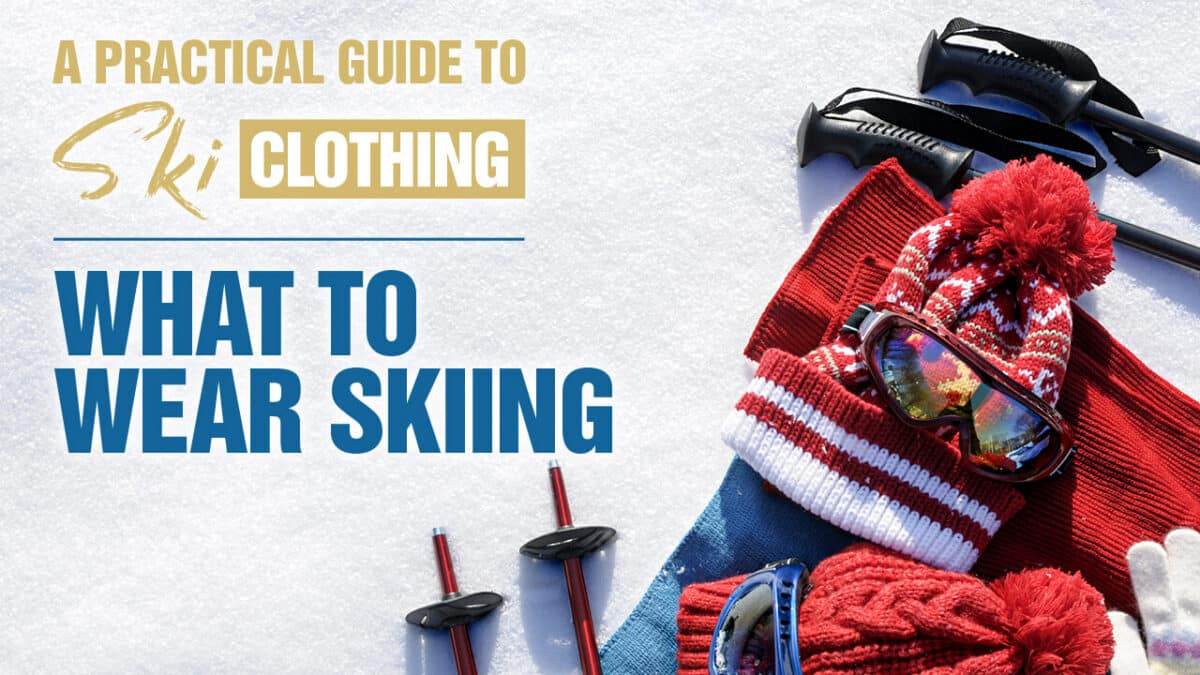When travelling long distances to go skiing, deciding what clothes to bring can be tricky. In fact, it can be challenging to decide what to wear on any given morning as Alpine weather changes so much.
But, with some background knowledge, your ski clothing choice can be much easier. Although it’s important, we’re not talking about style and fashion. Instead, we’re talking about the balance between warmth and comfort. So, in this article, we’ll tell you everything you need to know about ski clothing for your next trip to the Alps.
The Basics of Layering Ski Clothing
Your layering strategy is your ticket to being warm and comfortable on the mountain. Here’s how it works:
1. Start with a Moisture-Wicking Base Layer for Warmth
The first layer should be a moisture-wicking base layer that acts as a second skin that draws sweat away from your body. This prevents the dreaded chill that comes with dampness and provides a snug, insulating barrier against the cold. When your core is warm, you can enjoy a full day of skiing comfortably.
2. Add An Insulating Mid-Layer to Trap Heat
Next, add an insulating mid-layer to capture body heat to stay snug even in freezing temperatures.
3. Add A Waterproof And Breathable Outer Layer
Your outer layer comprises your ski jacket and pants, which have at least some level of waterproofing and breathability. This layer ensures that you stay dry and shielded from the cold winds. Plus, it prevents heat loss to the external environment.
Layering isn’t just about throwing on as many clothes as possible. It is a strategy to create your own personalised microclimate. Your layering method may differ from others in your group, as you may feel the cold more easily or have different priorities. Therefore, fine-tuning your layering is a case of trial and error. But, essentially, everyone should adopt the three different layer types mentioned above.
Waterproofing – Keeping Dry on the Slopes
When choosing outer layers to stay dry, it’s good to know that not all materials are created equal.
Top-notch waterproof fabrics like Gore-Tex, eVent, or similar high-performance materials are fantastic at keeping snow and moisture out. Other waterproofing comes from DWR coatings and other treatments. Outer layers using this method are often cheaper but not as good as clothing made with high-end fabrics. However, you may not need anything too special if you’re a fair-weather skier.
For families hitting the slopes together, you must ensure your kid’s outer layers are waterproof. A soggy and cold child is not fun to be around, and it could be potentially dangerous due to low air temperatures. Also, when your child is warm and dry, they can build snowmen and have snowball fights without wearing soaked clothing.
Understanding Waterproof Ratings: Navigating the Waters of Protection
Outer layers have a waterproof rating, often measured in millimetres (mm). This rating indicates a fabric’s ability to keep water out. The higher the number, the more resistant the material is to water. It is best to aim for a minimum of 5,000mm for light snow conditions and go higher for wetter weather or prolonged exposure to snow.
Breathability – Staying Cool While Staying Warm
Skiing is a dynamic, physically demanding sport that can make you sweaty if your clothing doesn’t have proper ventilation. Good outer layers are breathable, helping your body regulate its temperature so you don’t feel uncomfortable and clammy.
When selecting outer layers for your family ski trip, it’s best to prioritise breathable options that cater to your preferences and activity levels. For example, adults who ski aggressively and energetically should consider an outer layer made from materials like Gore-Tex for its excellent breathability.
Breathability ratings of outer layers are indicated in grams per square meter per 24 hours (g/m²/24h). A higher rating offers better breathability. Aim for a minimum of 5,000g/m²/24h for casual skiing, while more active skiers might opt for 10,000g/m²/24h or higher.

Insulation – Fighting Off The Cold With Warmth
For Kids:
- Opt for synthetic insulation for youngsters. It retains heat even when wet, making it resilient against snow and rain.
- Consider jackets with adjustable features to accommodate growth spurts so they can wear them more than once.
For Teens and Adults:
- Down insulation provides exceptional warmth and is perfect for colder conditions.
- Look for jackets with strategically placed insulation, allowing for flexibility and freedom of movement during active skiing.
For High Activity Levels:
- Primaloft and similar high-performance synthetic insulations are ideal. They offer warmth without adding bulk, allowing unrestricted movement during intense skiing. However, you may prefer to wear an outer layer without insulation if you’re hiking into the mountains or ski touring.
Understanding Insulation Ratings in Ski Jackets
Ski jackets often feature insulation ratings in grams, indicating the amount of insulation material used. Some have different insulation ratings in the body to the arms.
Suppose you want light warmth for mild temperatures. In that case, you may want to consider insulation around the body starting from a rating of 80g/m². Go up to 100-120g/m² for light warmth, 200g/m² for mid-level warmth, and 200g/m² and above for superior warmth in freezing conditions.
Sleeves typically have less insulation to prevent movement restriction and overheating while skiing. Look for jackets with sleeves rated around 60-80g/m² for a comfortable balance of warmth and flexibility.
Must-Haves for Young Skiers
Kids have their own requirements for ski gear; here are some tips to get you started:
- Jackets with Fun Prints: Opt for jackets featuring playful prints and vibrant colours. It adds a touch of fun and makes it easier to spot them on the slopes. Teens appreciate style. Look for jackets that blend fashion and technical features, such as multiple pockets, vents, and adjustable hoods.
- Adjustable Snow Pants: Choose snow pants with adjustable features to accommodate growth spurts. Look for reinforced knees for durability during snowball fights and wipeouts.
- Child-Specific Goggles: Invest in goggles designed for smaller faces with vibrant tints. It enhances visibility and protects young eyes from the reflective snow.
- Touchscreen-Compatible Gloves: Teens are always on their phones, so choose gloves with touchscreen compatibility, allowing them to snap pics and select their favourite tunes.

Other Ski Clothing Items
Now you know all about the technical side of clothing, let’s talk about the other things you should wear while skiing:
Ski Socks
Proper ski socks made from materials like merino wool or synthetic blends are essential for all-day comfort while skiing. They provide warmth, moisture-wicking, and crucial padding for your feet during long hours on the slopes. The material also prevents blister-causing friction.
Helmet
Your head is precious, and a helmet is non-negotiable. It protects against potential injuries, providing peace of mind while navigating the slopes.
Sunglasses Or Goggles
Protect your eyes from the glaring sun, reflective snow, and chilly winds. Sunglasses or goggles enhance visibility, reduce glare, and shield your eyes from potential hazards. Make sure you buy ones fitted with lenses with full UV protection.
Ski Gloves
Proper ski gloves provide insulation, waterproofing, and dexterity, ensuring your hands stay warm and nimble enough to hold your ski poles in low temperatures.
Neck Gaiter/Buff
A neck gaiter or buff is a versatile piece of ski clothing that protects your neck and face from biting winds and snow. It can also be used to block the sun from your face.
Rent Your Ski Clothing – An Alternative To Bringing Your Own
When travelling long distances, you may want to avoid carrying a suitcase full of ski clothing across the world. Luckily, there’s a solution with our ski clothing rental partner, Les Petits Montagnards.
Les Petits Montagnards is based in Annecy, France. From this location, they can deliver quality rental ski clothing all across the French Alps. Their clothing range comes from well-known brands, so you know you’re wearing quality items, and they are available for adults and kids.
Renting your ski clothing is more than just convenient; it is better for the environment. You can reduce the carbon footprint of your trip by renting ski clothing instead of buying it, reducing clothing waste and its environmentally harmful production.
In addition to this, renting your ski outfit means you have up-to-date style and innovations without buying new items each year.
Final Thoughts
There may seem to be a lot to take in regarding ski clothing. But essentially, you need to consider layering, breathability, waterproofing, and insulation.
When you book your holiday with us, ask our travel experts about your resort and the timing of your trip. Knowing about the typical temperatures and weather conditions may help you choose the correct ski clothing.

